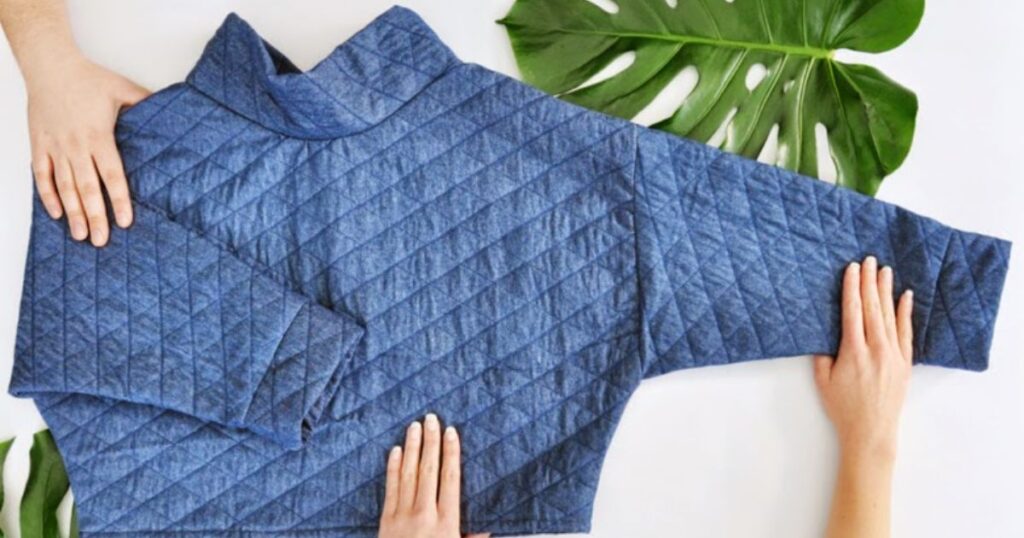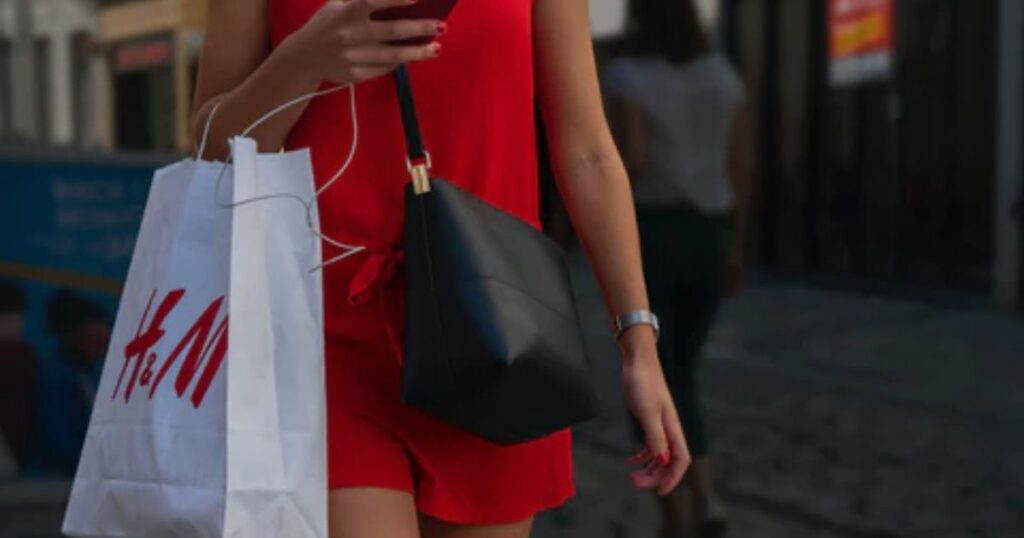Aritzia, while professing allegiance to the sustainability cause and espousing a commitment to an eco-conscious future, faces scrutiny from consumers questioning the authenticity of its efforts.
Skepticism abounds, with many wondering aloud, “Is Aritzia still adhering to the fast fashion model in 2024?” In the following analysis, we’ll delve deep into the reality behind Aritzia’s business practices and its touted sustainability endeavors, shedding light on the veracity of its claims.
Is Aritzia Fast Fashion?
While positioning itself as a premier Canadian label, Aritzia prides itself on curating an ethos of ‘Everyday Luxury’, boasting a straightforward objective – providing opulent goods paired with impeccable service, all within environments that inspire aspirations.
Yet, this allure veils a darker reality, as the brand inadvertently perpetuates the fast fashion paradigm through the utilization of synthetic materials, excessive production, and veiled sustainability efforts. Shielded by a carefully cultivated image, third-party evaluations of its practices remain elusive.
“Transparency regarding material sourcing and production methods is imperative for consumers to make conscientious decisions. While the banishment of fur marks a positive step, it merely scratches the surface of the broader issues we must confront.”
Aritzia And Sustainability: What We Know So Far

Since 2010, Aritzia has been championing sustainability, starting with the ban on fur. However, they still use synthetic fabrics that aren’t biodegradable. Fast forward to 2024, Aritzia has expanded its commitment to animal welfare by prohibiting angora and mohair. Yet, it’s unclear why these materials, if responsibly sourced, are deemed harmful to animals.
Despite the availability of ethical animal products, Aritzia opts for a blanket ban, possibly to give off an eco-friendly image without exploring sustainable alternatives. Meanwhile, their use of rayon, viscose, and polyester contributes to marine life degradation and introduces toxins into the food chain. The brand’s habit of overproduction exacerbates these environmental impacts, perpetuating a harmful trend cycle.
Is Aritzia Fast Fashion? Synthetic Materials
Presently, Aritzia incorporates a variety of materials into its products, including natural, synthetic, and animal-derived ones, along with wood-based cellulosics like lyocell, viscose, and modal. While some of these materials adhere to ethical standards, the majority raise significant environmental and safety concerns.
According to Aritzia’s ESG sustainability Report for FY2023, the brand offers the following insights:
- Between 2021 and 2022, Aritzia saw a notable increase in its utilization of synthetics, rising from 36% to a striking 44%.
- Conversely, the employment of cotton decreased from 39% to 32% during the same period.
- This downward trend in material usage extends to animal-derived fabrics as well, with Aritzia reducing their overall incorporation from 16% to 12%.
Also read this Post: ACUBI FASHION
Overall, a discernible pattern emerges: Aritzia is increasingly favoring non-biodegradable synthetics like polyester, polyamide, nylon, and elastane, while stepping away from natural fabrics.
Toxic Fabrics at Aritzia: What You Need to Know
Let’s examine a typical sweater from Aritzia. Above, you’ll notice it’s crafted from a semi-sustainable cellulosic fiber known as ECOVERO Viscose, alongside virgin synthetics like polyester, nylon, and elastane.
These synthetic materials are among the most harmful in fashion due to their origins in fossil-based chemicals. Polyester, elastane, and nylon contain carcinogenic compounds such as formaldehyde, phthalates, azo dyes, and heavy metals like lead and cadmium. These substances permeate the environment, eventually accumulating in our bodies and causing lasting harm.
Given this, it’s important not to be swayed by Aritzia’s claims of animal welfare or sustainability, particularly regarding their choice of fabrics. By embracing petroleum-based materials, the brand contributes to textile waste and exposes consumers to harmful toxins.
A Small Percentage of Responsibly-Sourced Fabrics

Aritzia proudly participates in the Good Cashmere Standard (GCS) initiative, ensuring ethical sourcing of cashmere that prioritizes the well-being of cashmere goats and their habitats. Highlighting this commitment, the brand emphasizes that 52% of its fall and winter 2022 cashmere items were responsibly sourced.
However, it’s essential to note that responsible cashmere accounts for just 4% of Aritzia’s use of animal materials, raising questions about the sourcing practices for the majority of its animal-based materials.
Animal-derived materials constitute only 12% of Aritzia’s overall collections, with synthetics dominating the remainder. This underscores the relatively modest impact of the Good Cashmere Standard (GCS) initiative within Aritzia’s broader material sourcing strategy.
What bout Other Animal Fabrics at Aritzia?
Essentially, Aritzia’s utilization of responsible cashmere is minimal, and the same goes for its initiatives like the Responsible Wool Standard (RWS) and Responsible Down Standard (RDS), ensuring ethical sourcing of some wool and down materials. However, only 2% of its animal-based fabrics are RWS wool, while a whopping 72% consist of regular wool, including merino.
This indicates a need for Aritzia to focus on where it sources the majority of its animal-based fabrics. Yet, the brand plans to delay addressing this until 2027, with the goal of transitioning all its animal-derived materials to responsible sources by FY27.
Aritzia’s Efforts Towards Ethical Labor: Superficial or Not?
Aritzia has recently aligned itself with sustainable initiatives such as the Sustainable Apparel Collection and Better Cotton Initiative within its supply chain. Additionally, the brand has engaged with the Better Work program and joined the Textile Exchange, showcasing a dedication to ethical labor practices.
While these steps suggest a commitment to environmentally conscious efforts, there remains uncertainty regarding the verification of Aritzia’s labor practices through third-party audit organizations.
Does Aritzia Use Ethical Labour?
Aritzia collaborates with fabric suppliers and factories across various countries like Vietnam, Turkey, Romania, Cambodia, and China for the production of their merchandise. However, specific details regarding labor conditions and the absence of forced labor remain undisclosed.
Despite its pledge to refrain from sourcing materials or services from regions associated with forced and child labor, Aritzia’s operations are linked to countries in the Global South where workers endure impoverished conditions and hazardous work environments.
Merely a small portion of Aritzia’s suppliers adhere to certified labor standards, which guarantee worker well-being, safety, and labor rights, hinting at its classification as a fast fashion entity.
Furthermore, Aritzia’s labor standards have been deemed subpar by Good On You, primarily due to insufficient evidence regarding the company’s commitment to ensuring its employees receive a living wage. The lack of transparency in its supply chain exposes questionable practices despite purported efforts to foster diversity and inclusion, with third-party validation reports remaining notably scarce.
Aritzia’s Positive Community-Building Initiatives
In 2020, Aritzia made a significant contribution by donating a thousand of their popular Super Puff jackets to disadvantaged Canadian women and teenage girls during the winter holidays. This initiative was part of the brand’s Community Giving Program, aimed at supporting the local community facing socioeconomic challenges.
In total, Aritzia has generously donated over 100,000 garments to the Union Gospel Mission, benefiting women experiencing homelessness in Vancouver, Canada. Additionally, the brand has contributed products worth $60 million through Aritzia Community partners, aiding more than 700,000 individuals.
As a result of their impactful philanthropic efforts, Aritzia was honored with the Excellence in Retail Philanthropy Award by the Retail Council of Canada.
A Failing Sustainability Mission?
In 2020, Aritzia publicly committed to achieving carbon neutrality, vowing to offset all carbon emissions generated by their offices, stores, and distribution centers. However, the brand has yet to furnish any evidence supporting this claim.
Aritzia received an unchanged overall score of 21-30% in the Fashion Transparency Index, signaling a lack of tangible advancements in transparency and sustainability compared to the previous year’s assessment.
Aritzia’s Vision for the Future

Aritzia, guided by its sustainability vision, appears committed to embracing eco-friendly practices. The company has recently committed to establishing science-based emissions targets within the next two years, marking a significant step in its partnership with the Science Based Targets initiative. This initiative, a global endeavor aiding companies in transitioning towards a net-zero economy, underscores Aritzia’s dedication to environmental stewardship.
However, while this pledge may signal Aritzia’s intentions to take tangible action, it’s essential to note that the brand’s target-setting process remains incomplete. Even if fully implemented, questions linger about the credibility of the SBTi framework itself.
Similar to Guess, a prominent fast fashion brand, many retailers are joining the industry’s collective efforts to curb emissions, aligning with the objectives of the Paris Agreement to limit global warming to 1.5°C. Despite these aspirations, the SBTi has faced criticism from experts for various reasons:
- Charging retailers a fee for accreditation, raising concerns about potential commercial motives.
- Operating without a sizable validation team, casting doubt on its ability to rigorously assess targets.
- Allowing retailers considerable freedom to modify and establish targets using tools of questionable reliability.
Fashionable Minimalism or Just Consumerism?
Aritzia’s allure lies in its stylish simplicity. Much like Everlane and Black Crane, the brand specializes in crafting high-quality, minimalist goods, predominantly in neutral hues such as white, beige, grey, and black. This aesthetic fosters an image of ethical and sustainable fashion practices.
The clean, classic designs of Aritzia’s offerings convey the impression of enduring essentials, designed to withstand the test of time. Yet, beneath the surface, the brand subtly promotes minimalism as a form of conspicuous consumption. This is exemplified by its emphasis on influencer marketing, with the likes of Kendall Jenner proudly showcasing her Super Puff coat to her vast following of 100 million.
Influencer marketing is a well-known strategy employed by fast fashion brands. Notably, Fashion Nova, a major player in the fast fashion industry, experienced a staggering 600% growth rate in a single year, largely attributed to its extensive influencer network.
Ultimately, mainstream consumers eagerly follow the brand endorsements of their idols, rushing to fast fashion outlets to emulate their style. Aritzia, with its strategic influencer marketing efforts, is undoubtedly vying for a slice of the ‘See Now, Buy Now‘ phenomenon.
The Trap Behind Minimalist Designs
In the realm of fashion, designs resonate louder than PR or marketing endeavors. Aritzia’s minimalist silhouettes hint at sustainability, yet they merely mimic the authentic eco-conscious ethos of smaller, sustainable brands.
Despite the subtle suggestion of eco-friendliness in its clean lines, Aritzia falls short of substantial evidence to support its sustainability claims. Price tags don’t always reflect ethical practices.
The Not-So-Sustainable Materials

Aritzia adamantly prohibits the inclusion of genuine fur and Angora rabbit hair in its merchandise. Instead, these materials are substituted with various synthetic alternatives, including what is termed ‘vegan fur’ (crafted from nylon/polyester) and PU leather. Despite this, such substitutions have been shown to pose risks to both environmental sustainability and human health.
The company’s official website asserts its commitment to reducing animal cruelty through the utilization of materials endorsed by the RDS (Responsible Down Standard). However, it’s important to note that this accreditation does not necessarily ensure comprehensive animal welfare.
Why is Aritzia So Popular?
Aritzia owes its widespread appeal to its fashionable brick-and-mortar outlets. Since its inception in 1984, the company has managed a network of over 100 boutiques across Canada, solidifying its status as one of the country’s premier brands. Its collection, primarily designed for women, showcases chic, refined, and understated pieces at moderate price points, available in distinctive urban locales.
Remarkably, Aritzia places significant emphasis on its physical storefronts, with online sales contributing only a third of its total revenue. As Mark Petrie highlights, Aritzia stores embody a fusion of value and quality, fostering an inviting atmosphere that entices shoppers to spend more time browsing and, consequently, to make more purchases—whether immediately or later online.
What is Fast Fashion and How to Tell if a Brand is One?
Fast fashion epitomizes inexpensive, trendy apparel, drawing inspiration from elite fashion and celebrity styles. Originating from luxury labels, trends swiftly disseminate to mass-market brands like Shein, H&M, and ROMWE, targeting everyday consumers.
These brands emulate haute couture designs using low-cost materials, exploiting cheap labor, and outsourcing production abroad. Operating in developing nations, they often disregard fair wages, subjecting workers to grueling hours for minimal pay, akin to modern-day slavery.
Moreover, the frenetic pace of fashion production has prompted a shift from the traditional four-season model to a staggering 52 seasons. This relentless cycle demands weekly collection updates to stay competitive in the market.
The hallmark features of fast fashion brands include:
Identifying Fast Fashion Traits
Spotting fast fashion brands can often be discerned through their choice of materials. Typically, these brands opt for synthetic fabrics such as polyester, nylon, and acrylic. While inexpensive to produce, these materials pose significant environmental risks compared to biodegradable alternatives. Keep an eye out for brands that are less forthcoming about their fabric compositions, as this is a common indicator of fast fashion.
Overproduction Practices
Fast fashion thrives on mass production of low-quality garments, designed to be quickly replaced rather than cherished. This constant turnover discourages investment in enduring pieces. Consequently, brands frequently purge unsold inventory once it falls out of favor, perpetuating a cycle of excess waste.
Transparency Concerns
A lack of transparency regarding production methods and supply chains is another hallmark of fast fashion brands. Consumers deserve access to information about sourcing, manufacturing, and labor practices. Brands that withhold this data may not be operating ethically, raising doubts about their credibility.
The Issue of Greenwashing
Greenwashing has emerged as a deceptive tactic within the fashion industry, where brands employ eco-friendly rhetoric to boost sales. Through “conscious collections” and misleading labeling, companies like H&M capitalize on consumers’ environmental concerns while failing to fully deliver on sustainability promises. It’s essential for consumers to conduct thorough research and scrutinize fabric compositions beyond surface-level labels to avoid falling prey to deceptive marketing tactics.
Is Aritzia Fast Fashion? Our Final Verdict
Considering everything mentioned, it’s now the moment to deliver the ultimate verdict on this specific Canadian brand. While their dedication to sustainability is acknowledged, the absence of substantial evidence supporting nearly all their public assertions raises significant concerns.
The deliberate omission of vital details like factory locations and specific production information further raises suspicions. In summary, despite the premium pricing, it’s probable that Aritzia operates as a fast fashion brand.
FAQ’s
Is Aritzia Considered Luxury?
Aritzia strikes a chord with mid-luxury and mainstream shoppers, notably Gen Z and Millennial women, offering stylish yet reasonably priced garments. Positioned between luxury and fast fashion, the brand crafts enduring apparel at accessible prices.
Is Aritzia Clothing Expensive?
The pricing of Aritzia apparel reflects the realities of operating physical stores, including expenses like rent and staff compensation. These overhead costs contribute to the perceived high prices of their clothing.
What Age Group is Aritzia For?
Aritzia’s clientele spans across a diverse demographic, with 18.87% male and 81.13% female customers. Primarily, the brand caters to Gen Z and Millennial consumers aged 18-24, resonating with their preferences and lifestyle.
Why Do Consumers Like Aritzia?
Aritzia garners favor among shoppers for its aesthetically pleasing store layouts and top-notch in-store experiences. Moreover, its affordable and fashionable offerings attract fast fashion enthusiasts who may overlook the brand’s sustainability efforts.







